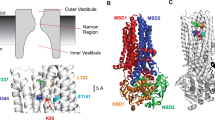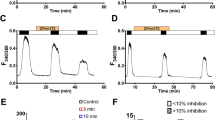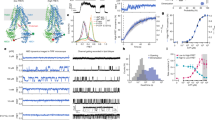Abstract
The cystic fibrosis transmembrane conductance regulator (CFTR) protein contains a canonical ATP-binding cassette (ABC) signature motif, LSGGQ, in nucleotide binding domain 1 (NBD1) and a degenerate LSHGH in NBD2. Here, we studied the contribution of the conserved residues G551 and G1349 to the pharmacological modulation of CFTR chloride channels by phloxine B using iodide efflux and whole-cell patch clamp experiments performed on the following green fluorescent protein (GFP)-tagged CFTR: wild-type, delF508, G551D, G1349D, and G551D/G1349D double mutant. We found that phloxine B stimulates and inhibits channel activity of wild-type CFTR (Ks = 3.2 ± 1.6 μM, Ki = 38 ± 1.4 μM) and delF508 CFTR (Ks = 3 ± 1.8 μM, Ki = 33 ± 1 μM). However, CFTR channels with the LSGDQ mutated motif (mutation G551D) are activated (Ks = 2 ± 1.13 μM) but not inhibited by phloxine B. Conversely, CFTR channels with the LSHDH mutated motif (mutation G1349D) are inhibited (Ki = 40 ± 1.01 μM) but not activated by phloxine B. Finally, the double mutant G551D/G1349D CFTR failed to respond not only to phloxine B stimulation but also to phloxine B inhibition, confirming the importance of both amino acid locations. Similar results were obtained with genistein, and kinetic parameters were determined to compare the pharmacological effects of both agents. These data show that G551 and G1349 control the inhibition and activation of CFTR by these agents, suggesting functional nonequivalence of the signature motifs of NBD in the ABC transporter CFTR.






Similar content being viewed by others
References
Aleksandrov L., Aleksandrov A.A., Chang X.B., Riordan J.R. 2002. The first nucleotide binding domain of cystic fibrosis transmembrane conductance regulator is a site of stable nucleotide interaction, whereas the second is a site of rapid turnover. J. Biol. Chem. 277:15419–15425
Atkins W.M. 2005. Non-Michaelis-Menten kinetics in cytochrome P450-catalyzed reactions. Annu. Rev. Pharmacol. Toxicol. 45:291–310
Bachmann A., Russ U., Waldegger S., Quast U. 2000. Potent stimulation and inhibition of the CFTR Cl− current by phloxine B. Br. J. Pharmacol. 131:433–440
Basso C., Vergani P., Nairn A.C., Gadsby D.C. 2003. Prolonged nonhydrolytic interaction of nucleotide with CFTR’s NH2-terminal nucleotide binding domain and its role in channel gating. J. Gen. Physiol. 122:333–348
Becq F., Mettey Y. 2005. Pharmacological interventions for the correction of ion transport defect in cystic fibrosis. Expert Opin. Ther. Targets 14:1465–1483
Berger A.L., Ikuma M., Welsh M.J. 2005. Normal gating of CFTR requires ATP binding to both nucleotide-binding domains and hydrolysis at the second nucleotide-binding domain. Proc. Natl. Acad. Sci. U.S.A. 102:455–460
Bronnikov G.E., Zhang S.J., Cannon B., Nedergaard J. 1999. A dual component analysis explains the distinctive kinetics of cAMP accumulation in brown adipocytes. J. Biol. Chem. 274:37770–37780
Cai Z., Sheppard D.N. 2002. Phloxine B interacts with the cystic fibrosis transmembrane conductance regulator at multiple sites to modulate channel activity. J. Biol. Chem. 277:19546–19553
Callebaut I., Eudes R., Mornon J.P., Lehn P. 2004. Nucleotide-binding domains of human cystic fibrosis transmembrane conductance regulator: Detailed sequence analysis and three-dimensional modeling of the heterodimer. Cell. Mol. Life Sci. 61:230–242
Chen M., Abele R., Tampe R. 2004. Functional non-equivalence of ATP-binding cassette signature motifs in the transporter associated with antigen processing (TAP). J. Biol. Chem. 279:46073–46081
Denning G.M., Anderson M.P., Amara J.F., Marshall J., Smith A.E., Welsh M.J. 1992. Processing of mutant cystic fibrosis transmembrane conductance regulator is temperature-sensitive. Nature 358:761–764
Derand R., Bulteau-Pignoux L., Becq F. 2002. The cystic fibrosis mutation G551D alters the non-Michaelis-Menten behavior of the cystic fibrosis transmembrane conductance regulator (CFTR) channel and abolishes the inhibitory genistein binding site. J. Biol. Chem. 277:35999–36004
de Weille J.R., Muller M., Lazdunski M. 1992. Activation and inhibition of ATP-sensitive K+ channels by fluorescein derivatives. J. Biol. Chem. 267:4557–4563
Dickinson K.E., Bryson C.C., Cohen R.B., Rogers L., Green D.W., Atwal K.S. 1997. Nucleotide regulation and characteristics of potassium channel opener binding to skeletal muscle membranes. Mol. Pharmacol. 52:473–481
Eudes, R., Lehn, P., Ferec, C., Mornon, J.P., Callebaut, I. 2005. Nucleotide binding domains of human CFTR: A structural classification of critical residues and disease-causing mutations. Cell. Mol. Life Sci. 62:2112–2123
Farley R.A., Faller L.D. 1985. The amino acid sequence of an active site peptide from the H,K-ATPase of gastric mucosa. J. Biol. Chem. 260:3899–3901
Gadsby D.C., Nairn A.C. 1999. Regulation of CFTR Cl- ion channels by phosphorylation and dephosphorylation. Adv. Second Messenger Phosphoprotein Res. 33:79–106
Gunderson K.L., Kopito R.R. 1995. Conformational states of CFTR associated with channel gating: The role ATP binding and hydrolysis. Cell 82:231–239
Kidd J.F., Ramjeesingh M., Stratford F., Huan L.J., Bear C.E. 2004. A heteromeric complex of the two nucleotide binding domains of cystic fibrosis transmembrane conductance regulator (CFTR) mediates ATPase activity. J. Biol. Chem. 279:41664–41669
Lewis H.A., Buchanan S.G., Burley S.K., Conners K., Dickey M., Dorwart M., Fowler R., Gao X., Guggino W.B., Hendrickson W.A., Hunt J.F., Kearins M.C., Lorimer D., Maloney P.C., Post K.W., Rajashankar K.R., Rutter M.E., Sauder J.M., Shriver S., Thibodeau P.H., Thomas P.J., Zhang M., Zhao X., Emtage S. 2004. Structure of nucleotide-binding domain 1 of the cystic fibrosis transmembrane conductance regulator. EMBO J. 23:282–293
Linsdell P. 2005. Location of a common inhibitor binding site in the cytoplasmic vestibule of the cystic fibrosis transmembrane conductance regulator chloride channel pore. J. Biol. Chem. 280:8945–8950
Loffler-Walz C., Quast U. 1998. Binding of K(ATP) channel modulators in rat cardiac membranes. Br. J. Pharmacol. 123:1395–1402
Melin P., Thoreau V., Norez C., Bilan F., Kitzis A., Becq F. 2004. The cystic fibrosis mutation G1349D within the signature motif LSHGH of NBD2 abolishes the activation of CFTR chloride channels by genistein. Biochem. Pharmacol. 67:2187–2196
Mitchinson C., Wilderspin A.F., Trinnaman B.J., Green N.M. 1982. Identification of a labelled peptide after stoicheiometric reaction of fluorescein isothiocyanate with the Ca2+-dependent adenosine triphosphatase of sarcoplasmic reticulum. FEBS Lett. 146:87–92
Moran O., Galietta L.J., Zegarra-Moran O. 2005. Binding site of activators of the cystic fibrosis transmembrane conductance regulator in the nucleotide binding domains. Cell. Mol. Life Sci. 62:446–460
Muallem S., Karlish S.J. 1983. Catalytic and regulatory ATP-binding sites of the red cell Ca2+ pump studied by irreversible modification with fluorescein isothiocyanate. J. Biol. Chem. 258:169–175
Ostedgaard L.S., Baldursson O., Welsh M.J. 2001. Regulation of the cystic fibrosis transmembrane conductance regulator Cl- channel by its R domain. J. Biol. Chem. 276:7689–7692
Randak C., Auerswald E.A., Assfalg-Machleidt I., Reenstra W.W., Machleidt W. 1999. Inhibition of ATPase, GTPase and adenylate kinase activities of the second nucleotide-binding fold of the cystic fibrosis transmembrane conductance regulator by genistein. Biochem. J. 340:227–235
Riordan J.R., Rommens J.M., Kerem B., Alon N., Rozmahel R., Grzelczak Z., Zielenski J., Lok S., Plavsic N., Chou J.L. Drumm, M.L.,Ianozzi C., Collins F.S.,Tsui L.C., et al. 1989. Identification of the cystic fibrosis gene: Cloning and characterization of complementary DNA. Science 245:1066–1073
Rovati G.E., Nicosia S. 1994. Lower efficacy: Interaction with an inhibitory receptor or partial agonism? Trends Pharmacol. Sci. 15:140–144
Schmitt L., Tampe R. 2002. Structure and mechanism of ABC transporters. Curr. Opin. Struct. Biol. 12:754–760
Sheppard D.N., Robinson K.A. 1997. Mechanism of glibenclamide inhibition of cystic fibrosis transmembrane conductance regulator Cl− channels expressed in a murine cell line. J. Physiol. 503:333–346
Sheppard D.N., Welsh M.J. 1993. Inhibition of the cystic fibrosis transmembrane conductance regulator by ATP-sensitive K+ channel regulators. Ann. N.Y. Acad. Sci. 707:275–284
Skou J.C., Esmann M. 1981. Eosin, a fluorescent probe of ATP binding to the (Na+ + K+)-ATPase. Biochim. Biophys. Acta 647:232–240
Tabcharani J.A., Chang X.B., Riordan J.R., Hanrahan J.W. 1991. Phosphorylation-regulated Cl- channel in CHO cells stably expressing the cystic fibrosis gene. Nature 352:628–631
Vankeerberghen A., Cuppens H., Cassiman J.J. 2002. The cystic fibrosis transmembrane conductance regulator: an intriguing protein with pleiotropic functions. J. Cyst. Fibros. 1:13–29
Walker J.E., Saraste M., Runswick M.J., Gay N.J. 1982. Distantly related sequences in the alpha- and beta-subunits of ATP synthase, myosin, kinases and other ATP-requiring enzymes and a common nucleotide binding fold. EMBO J. 1:945–951
Acknowledgement
We thank Dr. V. Thoreau, Dr. F. Bilan, Dr. K. H. Karlson and Dr. B. A. Stanton for the pS65T/EGFP-C1/WT-CFTR construct; Marlène Baudis for the delF508-CFTR construct; and N. Bizard for assistance with cell cultures. This work was performed as part of the thesis of P. M. at Ingénierie chimique, Biologique et Géologique (ICBG) thesis school at Poitiers University, supported by a thesis fellowship from the Region Poitou-Charentes. This work was also supported by specific grants from CF-Pronet and Vaincre La Mucoviscidose and an institutional grant from the CNRS and Région Poitou-Charentes.
Author information
Authors and Affiliations
Corresponding author
Rights and permissions
About this article
Cite this article
Melin, P., Norez, C., Callebaut, I. et al. The Glycine Residues G551 and G1349 within the ATP-Binding Cassette Signature Motifs Play Critical Roles in the Activation and Inhibition of Cystic Fibrosis Transmembrane Conductance Regulator Channels by Phloxine B. J Membrane Biol 208, 203–212 (2006). https://doi.org/10.1007/s00232-005-7001-0
Received:
Revised:
Published:
Issue Date:
DOI: https://doi.org/10.1007/s00232-005-7001-0




